Best Open Source CRM Software for 2025: Top 8 Picks Reviewed
TL;DR
- Open source CRMs give you full control over your data, workflows, and hosting.
- They’re ideal for teams that want flexibility, transparency, and long-term cost savings.
- Expect a steeper learning curve—setup often requires time, tech skills, or both.
- We tested 20+ tools and narrowed it down to 8 worth your effort.
Open source CRMs give you full control over your data, your workflows, and your budget.
This is the ideal software solution if you want to host your own system, customize features by editing the code, or avoid getting locked into changing vendor policies. Many are supported by active user communities and offer long-term flexibility as well.
We tested over 20 open source CRMs and narrowed it down to eight picks. These tools work well for teams who value autonomy and transparency but are also comfortable investing time and resources into setup.
You’ll learn what each CRM does best and what to watch out for before diving in.
The best open source CRM tools
- SuiteCRM for getting started fast & strong community support
- Odoo for combining CRM + ERP in one flexible, modular platform
- Vtiger for growing teams that want a stable CRM with easy upgrade paths
- EspoCRM for developers who want full control and clean, customizable architecture
- Flectra for teams requiring deep customization capabilities
- X2CRM for managing processes & business operations
- Crust CRM (Corteza CRM) for exceptional data privacy & protection
- YetiForce for ultimate internal operations management
What is an open source CRM system?
An open source CRM is customer relationship management software that gives you full access to its source code, so you can host it yourself, change how it works, and tailor it to your business. It’s not just about saving money. It’s about control. You decide how it looks, what it tracks, and where your data lives.
You might choose an open-source CRM if you:
- Know how to self-host & want to avoid monthly SaaS fees
- Need flexibility to customize features, fields, or workflows
- Care about data privacy and ownership
- Prefer tools backed by developer communities
- Have internal dev resources (or patience) for setup and maintenance
Compared to most commercial CRMs, open source options offer similar core features, like contact management, pipelines, automation, and reporting, but typically require more time and technical skill to get up and running.
What makes the best open-source CRM?
Our hands-on testing process
We don’t just read spec sheets—we install, break, rebuild, and explore every tool like real users would.
We spend hours testing every CRM we write about to ensure our readers get the most accurate, up-to-date information. All reviews are vetted by our in-house expert, Andrew Chao Daongam, a seasoned CRM consultant and Solutions Architect with almost a decade of experience.
We want you to feel confident that the CRM you choose will support your day-to-day, not slow you down. Here’s what we looked for:
- Ease of use: How fast can a new user get started? Is it intuitive or confusing?
- CRM features depth: Pipelines, contact management, tasks, reporting, integrations.
- Customization: Can you tweak fields, workflows, and modules without code?
- Hosting and maintenance: Self-host or cloud, with simple setup and scaling?
- Community and support: Is it actively maintained? Do users help each other?
We created test companies, loaded dummy data, and ran daily tasks like a real sales or support team would. When tools broke, we noted how fast we could fix them, and whether the docs helped.
Open source CRM comparison chart
Product | Best for | Pricing | Website |
SuiteCRM | Quick setup & strong community | Free (self-hosted) | |
Odoo | Managing CRM + operations | Free (1 app only) | |
Vtiger | Scaling teams | Free (10 users & 3000 records) | |
EspoCRM | Building custom workflows | Free (self-hosted) | |
Flectra | Deep customization | Free (self-hosted) | |
Crust CRM (Corteza CRM) | Data privacy | Free (self-hosted) | |
X2CRM | Managing processes | Free (self-hosted) | |
YetiForce | Internal operations | Free (self-hosted) |
Best open source CRM for getting started fast
SuiteCRM
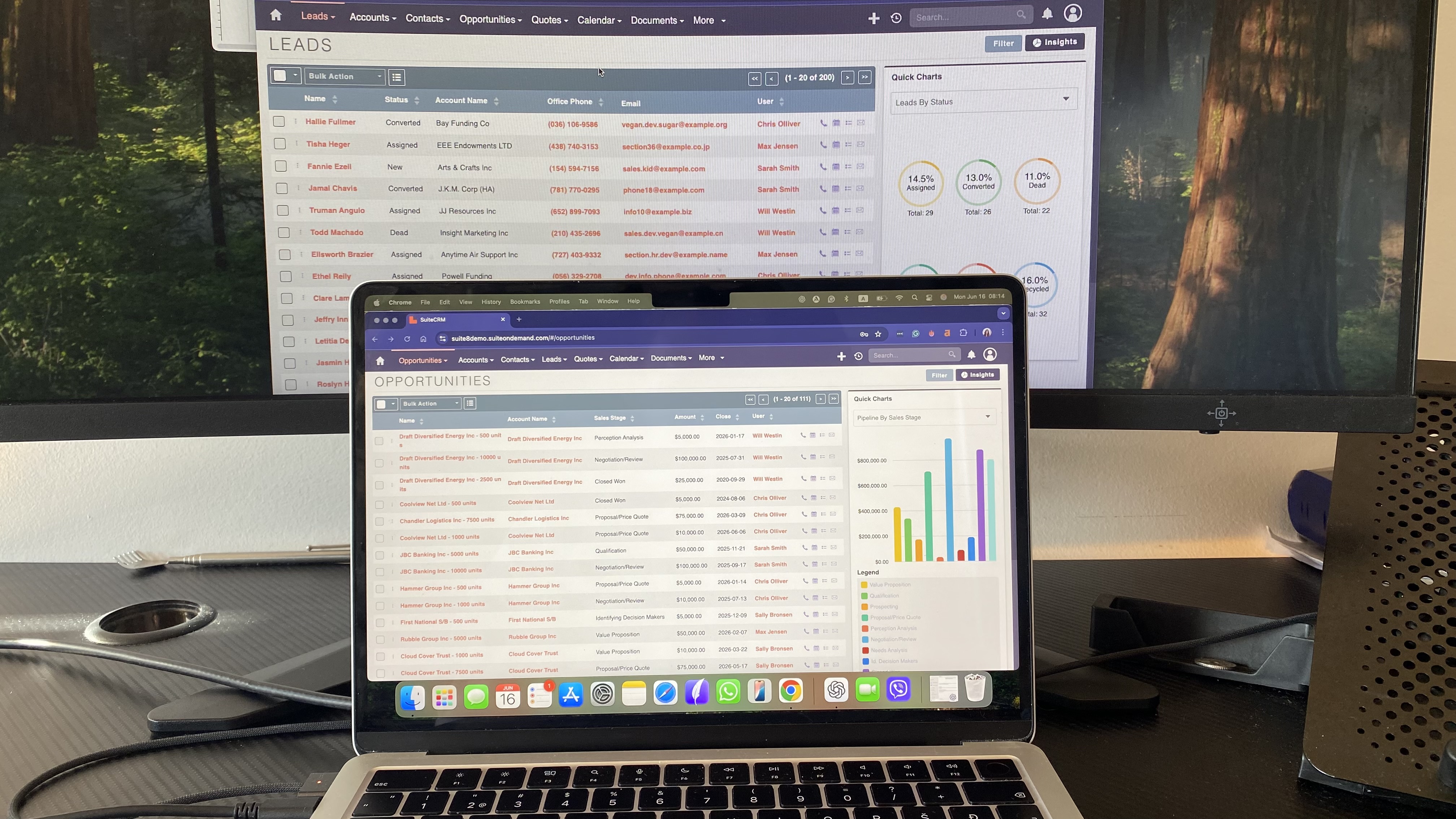
Pros
- Completely free when self-hosted
- Built-in tools for sales, marketing, and support
- Modular and highly customizable
- Strong community and open codebase
Cons
- Dated UI and limited modern automation
- Requires technical setup and server maintenance
- Fewer integrations out of the box
SuiteCRM is one of the few open source CRMs that gives you the full suite, contacts, pipelines, reporting, email, cases, quotes, without putting anything critical behind a paywall.
When I set it up, I had a working instance within the hour. The admin panel looks a little old-school, but the system is powerful and predictable. It’s especially strong at visualizing pipeline health through stages, deal values, and close probabilities.
Customizing it takes some learning, but I appreciated how granular I could get with fields, user roles, and module visibility. I also liked the active user forums and documentation, which made the self-hosting process less intimidating.
Just be aware that you’ll probably need technical help unless you’re comfortable with server configs and permissions. But, for teams with IT resources or CRM consultants on call, SuiteCRM offers enterprise-level customization at zero cost.
If you want a free, flexible CRM that works like a traditional enterprise tool, SuiteCRM gives you full control without license limits. It won’t win design awards, but it’ll grow with you.
Pricing
Free forever if you self-host. Cloud hosting starts at £130/month (~$165) for up to 10 users.
Helpful next steps
- Read our SuiteCRM review
- Test SuiteCRM for free
Visit site
Go to SuiteCRM
Best open source CRM for managing CRM + operations
Odoo
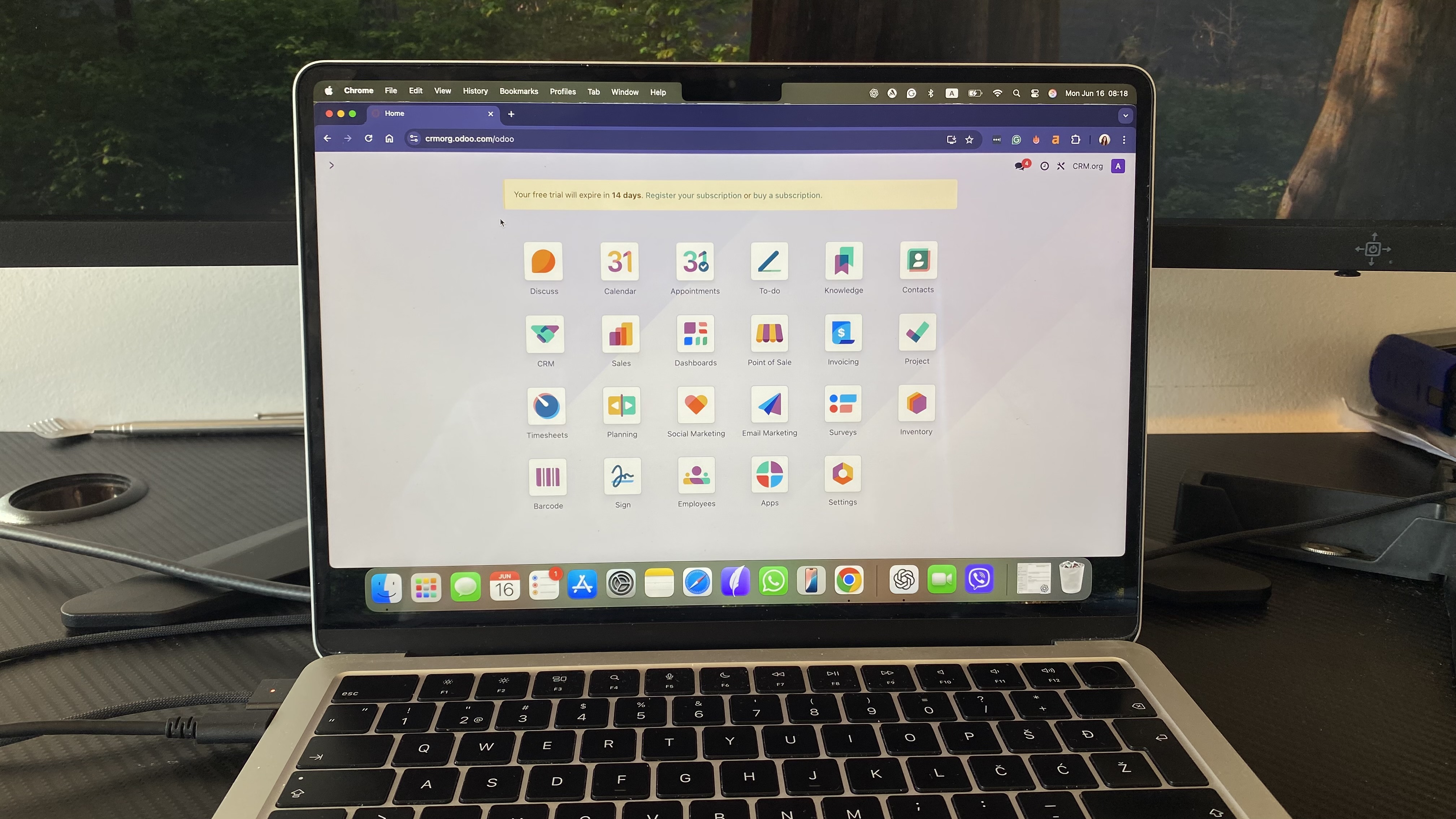
Pros
- Modular system that grows with your business
- Seamless integration across CRM, finance, inventory, HR, and more
- Strong sales tools like Kanban pipelines and lead scoring
- Free Community Edition with full access to core CRM features
Cons
- Setup can be complex without technical help
- Reporting and advanced automation require customizations or paid apps
- No direct support unless you’re on a paid plan
Odoo feels more like a business control panel, rather than a CRM. When I logged in, the app dashboard looked more like a modern ERP than anything else, and that’s exactly the point.
The CRM module is just the start. You can add invoicing, project management, time tracking, inventory, or email marketing as needed. Everything talks to each other out of the box, so you don’t spend time stitching systems together.
In testing, I appreciated how smoothly leads moved from pipeline to quote to invoice, without ever needing to export a CSV. The Kanban board is easy to customize, and you can build custom workflows or trigger activities based on lead score, status, or team assignments.
The learning curve is real, and some modules like accounting or inventory take time to master. But if you’re thinking long-term and want a system that scales with you, Odoo’s open-source foundation gives you serious flexibility, with or without a subscription.
And, speaking of subscriptions, you can self-host the Community Edition or use Odoo’s paid cloud hosting, depending on how hands-on you want to be.
Pricing
Free forever plan for one app (e.g., just CRM). Paid plans start at $19.90/user/month; all apps included.
Helpful next steps
- Read our Odoo review
- Test Odoo for free
Visit site
Go to Odoo
Best open source CRM for growing teams
Vtiger
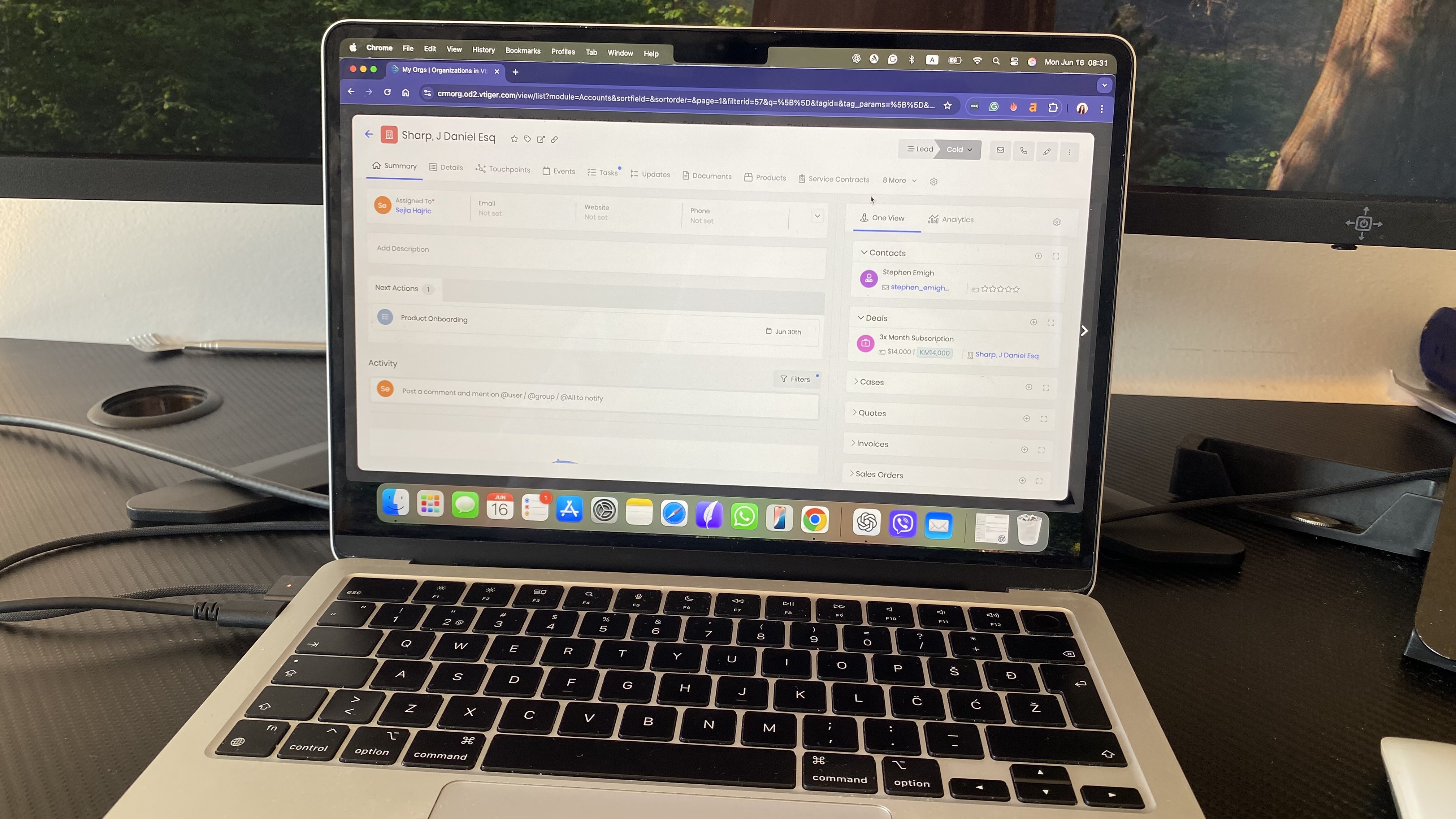
Pros
- One View combines all customer data and activity in one place
- Covers sales, support, inventory, and project tracking
- Open source edition is free and customizable
- Helpful AI nudges in cloud version
Cons
- Advanced AI, reporting, and insights are cloud-only
- Module navigation can be clunky
- Self-hosting requires technical setup and upkeep
Vtiger is a solid middle ground between flexibility and user-friendliness. The interface is clean and modern, with quick access to key actions like assigning tasks, updating records, or reviewing past interactions.
Its signature One View feature pulls together emails, deals, tasks, contacts, cases, and documents into a single, scrollable timeline. This is a big plus if your sales and service teams need to work off the same page without toggling between tabs or apps.
The open source edition includes core CRM tools like pipeline tracking, workflow automation, inventory, and project management. I found the setup manageable, though not quite plug-and-play, expect some backend fiddling if you’re hosting it yourself. Though, there is an active user community and decent documentation, which will help you troubleshoot if you hit snags.
Customizing fields and views is fairly straightforward, and the growing add-on marketplace helps fill gaps like integrations and reporting. While you won’t get Vtiger’s AI tools or deep analytics without moving to the cloud version, the free edition holds its own for scaling teams.
If you want a CRM that grows with you, and you’re okay doing a bit of the lifting, Vtiger is a dependable place to start.
Pricing
Free forever for up to 10 users & 3000 records. Paid plans start at $12/user/month, billed annually.
Helpful next steps
- Test Vtiger for free
Visit site
Go to Vtiger CRM
Best open-source CRM for full customization
EspoCRM
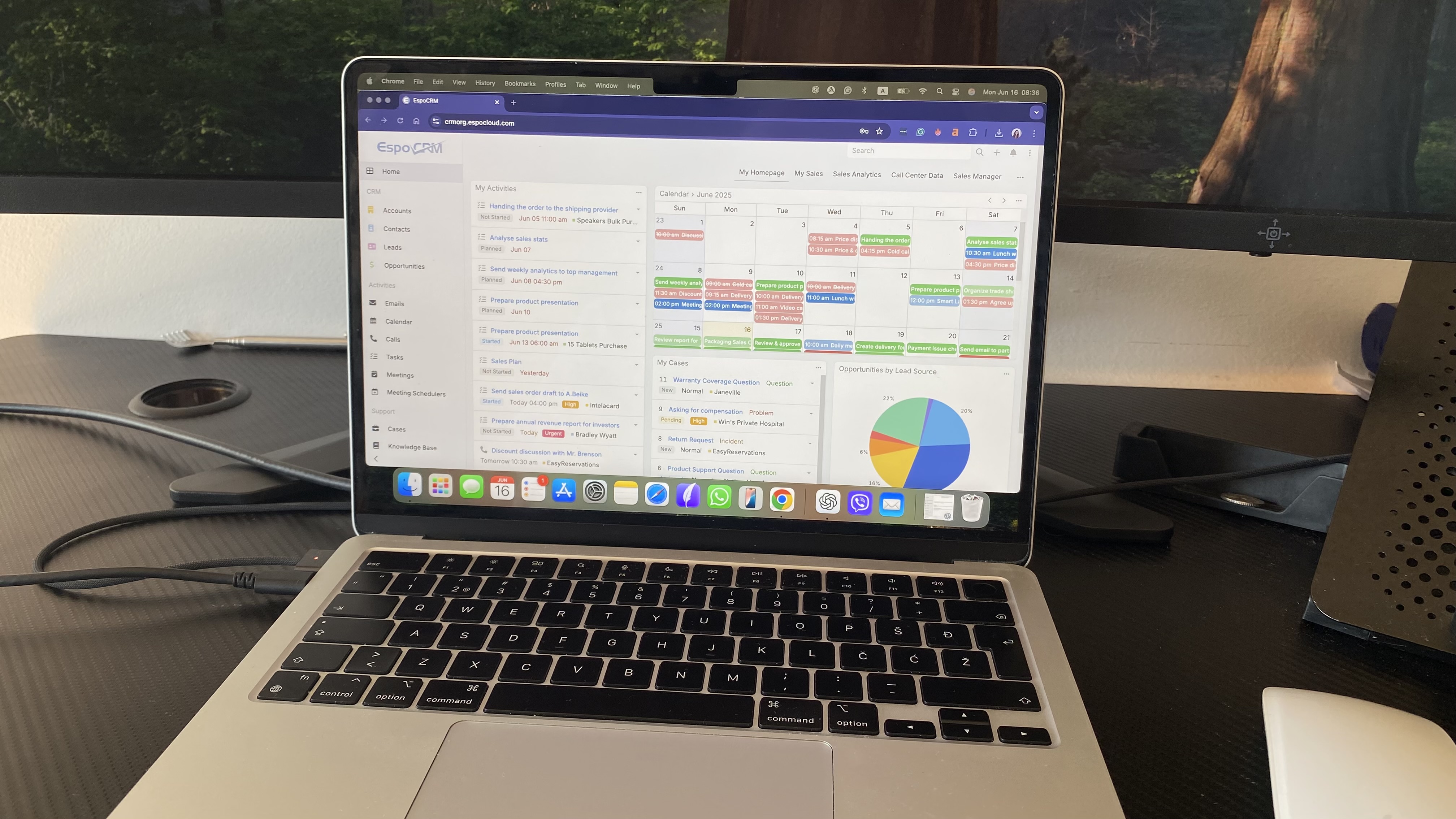
Pros
- No-code customization with Entity Manager
- Lightweight, fast, and ideal for self-hosting
- Built-in tools for tasks, leads, cases, and pipelines
- Clean UI with functional dashboards
Cons
- Limited built-in reporting tools
- Requires technical confidence to install and configure
- Smaller ecosystem than more popular CRMs
EspoCRM feels like a CRM built by developers who understand how non-developers work. When I logged into the dashboard, I had everything I needed: calendar, activities, case status, and even a breakdown of lead sources, right on the homepage. The UI is clean and easy to scan, with no unnecessary clutter. I didn’t have to dig around for tasks or sales data.
What stood out was how customizable it is without touching a line of code. The Entity Manager lets you create custom modules, fields, and relationships, whether you’re tracking contracts, installations, events, or anything industry-specific. I appreciated how easily I could reshape the CRM around my own processes without calling in a developer.
It does require some comfort with self-hosting and configuration, and reporting is basic unless you extend it with add-ons. But for small to mid-sized teams that want full control and don’t need flashy marketing tools, EspoCRM is one of the most capable and genuinely flexible CRMs out there.
Pricing
Free forever when self-hosted. For cloud solutions, try out free one-month trial or contact Espo CRM for pricing.
Helpful next steps
- Test EspoCRM for free
Visit site
Go to EspoCRM
Best open source CRM for deep customization
Flectra
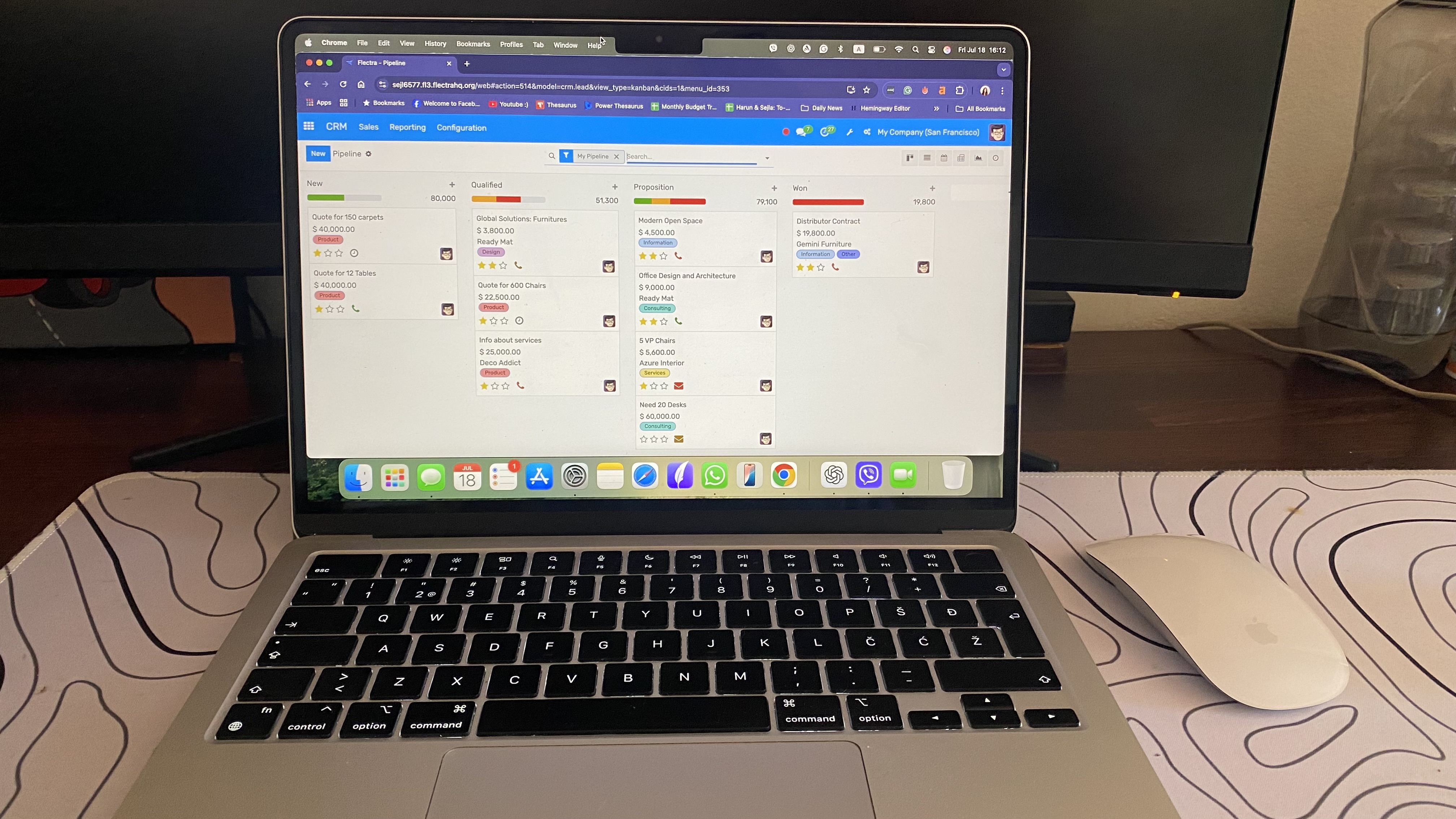
Pros
- Modular design makes it easy to customize
- Includes project management and billing tools
- Active developer community
Cons
- Can feel overwhelming out of the box
- Sparse user-level documentation
Flectra is what happens when a CRM meets a Swiss Army knife. You get core CRM features (leads, pipelines, activities), but also inventory management, HR tools, and billing modules baked in.
What stood out to me was how modular everything felt. Want to strip it down to just CRM and tasks? You can. Want to go full ERP? That’s doable too. You don’t need to touch code to rearrange fields or workflows, but a developer can dive into Python-based customization if you want to go deeper.
Just know that while Flectra’s backend is a dream for tinkerers, the frontend can feel like a lot for everyday users. I’d recommend setting up custom dashboards or role-based views to simplify things for your team.
Pricing
Free forever (self-hosted). Paid cloud hosting starts at $19/user/month.
Helpful next steps
- Test Flectra for free
Visit site
Go to Flectra
Best open source CRM for process-driven teams
X2CRM
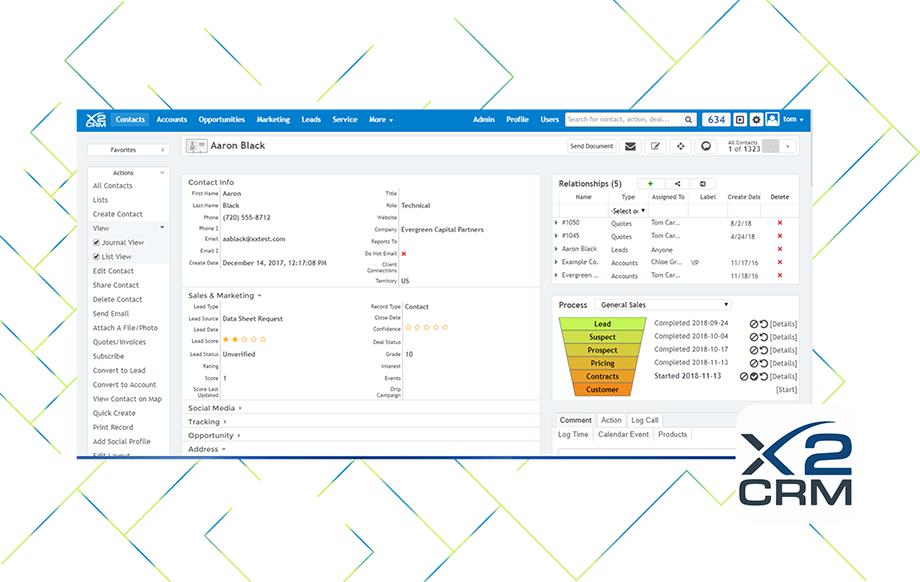
Pros
- Powerful workflow and automation engine
- Built-in marketing and service tools
- Clean, responsive UI
Cons
- Outdated documentation in places
- Limited integrations out of the box
X2CRM stands out because it lets you map your entire customer journey, from lead to support ticket. I especially liked the Visual Process Engine, which makes automating complex tasks feel less like writing code and more like solving a puzzle.
There’s a lot under the hood: campaign tracking, email drip tools, customer service cases, product catalogs. It’s ideal for teams that want one tool to do it all without paying for five different platforms.
The UI feels more polished than many open source CRMs I tested. But the learning curve is steeper if you want to use advanced features, mostly due to thin documentation. You’ll probably rely on trial and error—or friendly help from the user forums.
Pricing
Free community edition (self-hosted). Paid hosting pricing is available upon request.
Helpful next steps
- Sign up for free trial or demo
Visit site
Go to X2CRM
Best open source CRM for data ownership and privacy
Crust CRM (now called Corteza CRM)
Pros
- Built on a modern low-code platform
- Strong access controls and audit logs
- Fully API-first and GDPR compliant
Cons
- Interface isn’t very beginner-friendly
- Setup requires some technical lift
Crust, now known as Corteza, is for teams that take data sovereignty seriously. It’s one of the few open source CRMs built explicitly with privacy, security, and compliance in mind. Think GDPR out of the box, not bolted on.
I appreciated how Corteza separates the CRM logic from the presentation layer. That means you can design your workflows exactly how you want them—fields, permissions, dashboards—and enforce tight controls on who sees what. The platform uses a low-code interface, so even non-developers can build custom modules with a bit of ramp-up.
That said, getting up and running does take some patience. If you’re not used to Docker or low-code builders, there’s a learning curve. But once set up, it’s rock solid and yours to own, no strings attached.
Pricing
Free (self-hosted). Enterprise support pricing available upon request.
Helpful next steps
- Test out Crust CRM
Visit site
Go to Crust CRM
Best open source CRM for internal ops and business management
YetiForce
Pros
- Over 80 modules built-in
- Strong focus on internal business processes
- GDPR-compliant and highly secure
Cons
- Clunky interface
- Some features buried or hard to find
YetiForce is a full command center for business operations. You’ve got modules for contracts, assets, call logs, support tickets, even holiday leave. If your CRM wish list includes more than just sales pipelines, this might be your all-in-one answer.
I tested YetiForce as a backend hub for internal operations—things like managing vendor contracts and internal tasks. It handled it well, with plenty of built-in structure but enough flexibility to adapt.
There’s no shortage of features, but they’re not always easy to find. Some menus are a few clicks deeper than you’d expect.
Still, for teams that care more about functionality than sleek UX (and have a bit of IT comfort) it delivers serious bang for zero bucks.
Price: Free forever (self-hosted). Cloud services start around $80/month. Paid implementation support is possible as well.
Helpful next steps
- Get started with YetiForce
Visit site
Go to Yetiforce
How to Prep for Implementing an Open Source CRM
Open source CRMs give you flexibility, control, and no per-seat pricing. But unlike SaaS tools, they don’t come prepackaged. You’re the pilot now—and that means a bit of prep is non-negotiable.
Before you dive in, here’s what you really need:
- Have a tech-savvy teammate: Someone comfortable with Linux, Docker, and basic system admin. Optional: light coding skills (PHP, Python, etc.) if you want deep customization.
- Set up a test environment: Don’t go live right away. Use a staging server to try out features, roles, and data imports safely.
- Clean and map your data: Audit contacts, deals, and fields from your old system. Prep import files (CSV, SQL) and match them to your new CRM’s structure.
- Plan access and backups: Create role-based permissions, install SSL, and set up automatic database backups before going live.
- Start small, then scale: Roll it out to one team or use case first. Gather feedback. Tweak. Then expand.
Open source CRM vs proprietary software: What’s the real difference?
If you’re weighing open source CRM tools against proprietary ones like Salesforce or HubSpot, here’s what you need to know.
Open source CRMs let you decide how your system runs, where your data lives, and what features matter most.
Proprietary CRMs, on the other hand, offer polished interfaces and built-in support, but you’re locked into their pricing, roadmaps, and terms of service.
Here’s what really sets them apart:
Open Source CRM
- You host it, you own it. Install it on your own server or cloud environment. No monthly license fees (but you may have to pay for hosting, if you don’t have your own server).
- Customize everything. Add fields, change modules, or rebuild workflows, often without touching code.
- No vendor lock-in. Your data stays under your control, and you’re not tied to a platform’s policy changes or feature limits.
- Strong for technical teams. Great fit if you have IT resources or want to build a custom-fit system.
- Support is community-based. You rely on forums, docs, and your own troubleshooting unless you pay for hosted support.
Proprietary CRM
- Turnkey experience. You sign up, log in, and get a polished tool right away, no server setup headaches.
- Premium support & updates. Paid plans usually include updates, bug fixes, and live help.
- Less flexibility. You work within the platform’s limits; deeper customizations can require pricey upgrades or consultants.
- Easier for non-technical users. Setup, integrations, and training tend to be more beginner-friendly.
- Recurring costs. Monthly or annual fees per user add up fast, especially as your team grows.
Wrap-up: Your CRM, your way
Open source CRM software gives you freedom, not just from price tags, but from constraints.
Choose open source CRM if you want full control, don’t mind rolling up your sleeves, and prefer not to be billed forever for using your own data.
Choose proprietary CRM if you want fast deployment, official support, and a system that works out of the box—even if it costs more over time.
In the end, it comes down to priorities: flexibility and ownership vs convenience and support. We’ll be right here cheering you on, code or no code.
Want to keep exploring? Try these next:
Open Source CRM FAQs
Is open source CRM really free?
Yes—at least the software is. You can download and use it without paying license fees. But there may be other costs, like hosting, setup, or hiring someone to help with customization if you’re not technical.
Do I need to know how to code?
Not always. Many open-source CRMs (like EspoCRM or SuiteCRM) let you customize fields and workflows without touching code. But if you want deep customizations or self-hosting, some technical know-how helps.
Can I migrate my data from another CRM?
Usually, yes. Most tools offer import options for CSV files, and some even have built-in migration tools or third-party extensions. Still, data mapping can take time, especially if your old CRM had lots of custom fields.
What about support? Who helps me if something breaks?
With open source CRMs, you’ll mostly rely on community forums, GitHub issues, or documentation. Some vendors offer paid support or hosted versions with SLAs, but it’s not the same as 24/7 chat from a big-name CRM.
Do open source CRMs have all the same features as paid ones?
Many of them cover the basics and then some: pipelines, tasks, contact management, dashboards, and even automation. But high-end features like AI insights, native phone dialers, or advanced analytics may require add-ons or extra setup.
Can I integrate open source CRMs with other tools?
Often, yes, but expect to do more of the connecting yourself. Some CRMs support REST APIs or Zapier. Others rely on plugins. Just don’t expect one-click integration with every SaaS tool out of the box.




